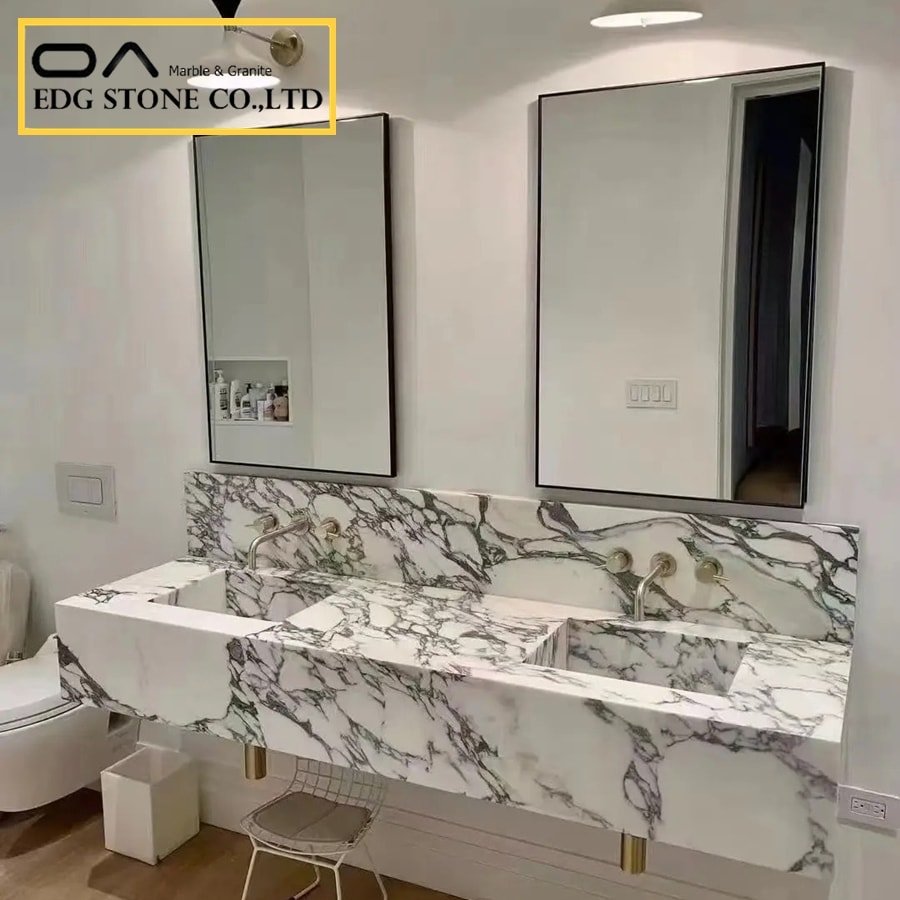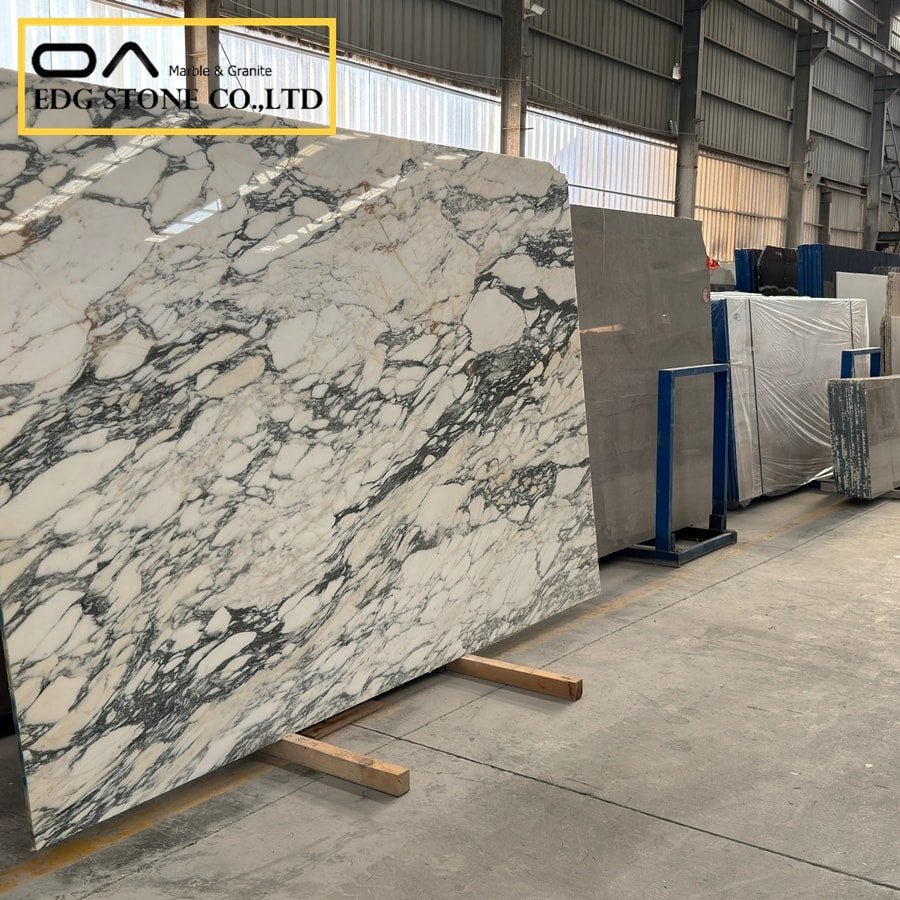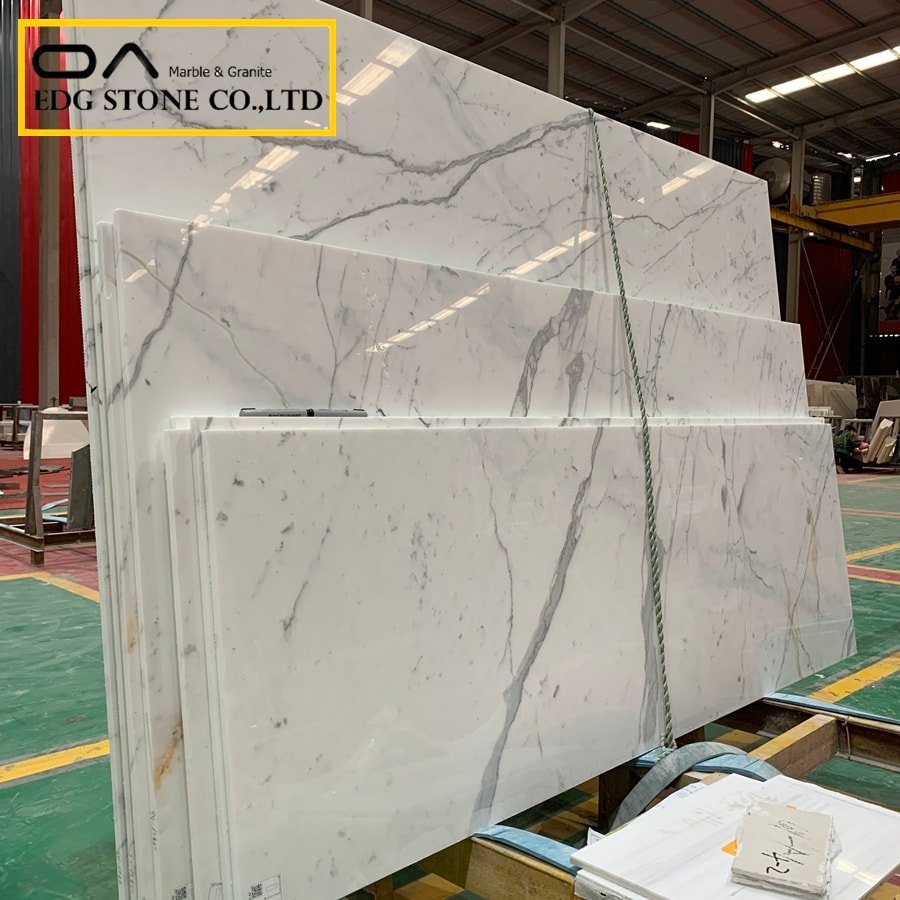Advantages of White Marble Tiles
Table of Contents
Toggle- Advantages of White Marble Tiles
- Best White Marble Recommendations for 2025
- In-stock marble slabs
- Top 10 White Marble Types Recommended by Designers
- Advantages of white marble tiles
- How to Clean and Maintain White Marble?
- Common stains and how to remove them
- White Marble Surface Treatment Tips
- Choosing the right cleaning tools for white marble
- Summary and recommendations
White marble tiles, as a high-end decorative material, are increasingly favored by consumers for their unique aesthetics and practicality.
First of all, white marble tiles are extremely durable, able to withstand friction and pressure from daily use, and are hardly prone to scratches, which is why they are commonly used in high-traffic commercial and residential spaces. Additionally, their heat resistance allows them to perform well in kitchens and other high-temperature environments, effectively resisting damage caused by temperature changes and direct contact with heat sources.
Another important advantage is the aesthetic appeal of white marble tiles. The unique textures and luster of marble lend a luxurious atmosphere to spaces, making white marble tiles an ideal choice for home decoration. Compared to other materials, such as ceramic tiles or wooden floors, marble tiles offer a unique visual effect that can elevate the overall quality of an interior space. Further analysis of their pros and cons shows that, although white marble tiles are more expensive than other materials like ceramic tiles, they excel in appearance and long-term quality performance.
Ceramic tiles are more prone to wear and loss of shine, while marble tiles, with proper maintenance, can maintain their beauty over time. Moreover, marble tiles also have a strong value retention, often fetching high prices in the second-hand market due to their uniqueness and superior quality.
In summary, white marble tiles not only excel in functionality, but their visual appeal and potential for value appreciation also make them an ideal choice for building and decorative materials. Whether for newly renovated homes or commercial spaces, white marble tiles can enhance the overall ambiance, creating a more elegant and comfortable environment for users.


Best White Marble Recommendations for 2025
In 2025, the market is flooded with a range of popular white marbles that are known for their elegant appearance and varied textures. White marble is not only widely used in home decoration, but also shows great beauty and suitability in commercial spaces. Different types of white marble are distinctive and suitable for a wide range of occasions.
First of all, Carrara marble from Italy is one of the most common white marbles on the market. Its elegant white base with subtle gray veining makes it ideal for kitchen countertops and bathroom décor. In addition, this marble’s abrasion resistance and smoothness make it a popular choice for engineered designs.
Another popular choice is Calacatta marble. Compared to Carrara marble, Calacatta has a warmer tone and a wider, more pronounced grain, giving it a luxurious feel. This makes it more prominent in interior design, especially on prominent walls and center countertops, in line with the modern family’s quest for style and aesthetics.
In addition, Thassos Marble is highly acclaimed for its pristine white color and smooth surface. It is the preferred choice of many high-end residences and hotels, and is often used for pool surrounds and wall décor, bringing an atmosphere of serenity and elegance. It is suitable for consumers who are looking for simplicity without sacrificing a sense of luxury.
Overall, choosing the right white marble requires considering your own needs and the style of your space. Whether you favor the classic Carrara, the luxury Calacatta, or the simplicity of Thassos, the 2025 white marble market will bring you a wealth of choices to ensure that you find the perfect fit.
In-stock marble slabs
In modern home décor and commercial space design, marble slabs are favored for their unique beauty and durability, especially white marble. There are several available types of spot marble slabs on the market, including white marble from different regions and mines, such as Carrara marble and Albanian marble. These spot marbles not only vary in color and texture, but also in texture and price.
When looking for spot marble slabs, consumers should focus on a variety of factors. First and foremost, choosing a marble should take into account their needs, including the environment in which it will be used (e.g., kitchen, bathroom, or other living space), as variations in humidity and temperature in different areas can affect the marble’s performance. In addition, budget is also an important consideration. With a wide range of prices for spot marble, consumers need to plan their budgets wisely according to their financial situation and design program.
In order to enhance the aesthetics of a home or commercial space, it is vital to choose the right white marble in stock. The natural texture and luster of marble can add a sense of luxury to an interior environment. When installing it, consider matching it with appropriate lighting and furniture, which can accentuate the beauty of the marble and create a harmonious overall atmosphere. Choosing the right spot for marble slabs not only improves the interior décor but also gives the space a unique artistic touch and enhances the overall value.

Top 10 White Marble Types Recommended by Designers
When choosing white marble, it is vital to understand the characteristics of the different types and the scenarios in which they are suitable. Here are the top 10 types of white marble recommended by designers and the benefits of each.
First up is Italy’s Carrara White Marble, whose elegant white color and subtle gray veining make it a classic choice for high-end residential and commercial spaces, often used for walls and floors.
Next up is Apollo White Marble, known for its bright white background and fine gold or gray streaks, suitable for bathroom countertops and kitchen islands for a contemporary home style.
Vagli White Marble, popular for its unique texture and hardness, is suitable for outdoor areas and is resistant to the elements.
Alternatively, Rome White Marble, characterized by its pure white color and smooth lines, is suitable for ceilings and wall decorations, creating a sense of transparency.
Miami White Marble, with its traditional mineral tones and uniform color, is suitable for commercial spaces such as hotel lobbies.
Angola White Marble, known for its strong veins and diverse color palette, is suitable for a wide range of applications, from wall coverings to functional countertops with flexible designs.
Other recommendations include Greek White Marble, Brazilian White Marble, Miele White Marble, and Snowflake White Marble. Each type of marble has a unique texture and application scenario that can fulfill different design needs.
With these recommendations, readers can be inspired when shopping for white marble and find the best material for their project. Whether used for residential or commercial spaces, each type of white marble has its irreplaceable charm and advantages.
Advantages of white marble tiles
As a high-end decorative material, white marble tiles are favored by more and more consumers for their unique aesthetics and practicality. First of all, white marble tiles are extremely wear-resistant, able to withstand the friction and pressure of daily use, and are hardly likely to leave scratches, and thus are often used in high-traffic commercial and residential spaces. In addition, its heat resistance allows it to excel in kitchens and other hot environments, effectively resisting damage caused by temperature changes and direct contact with heat sources.
Another important advantage is the aesthetics of white marble tiles. The characteristic texture and luster of marble lend an air of luxury to a space, making white marble tiles an ideal choice for home décor. Compared to other materials, such as ceramic tiles or wooden floors, marble tiles have a unique visual effect that enhances the overall class of the interior space.
Further analyzing its advantages and disadvantages, white marble tiles have an advantage over other types of materials, such as ceramic tiles, in terms of appearance and quality performance over time, despite their higher price. While ceramic tiles are more prone to wear and loss of luster on their surface, marble tiles are able to maintain their long-lasting beauty with proper maintenance. In addition, marble tiles retain their value better, often fetching higher prices on the secondary market due to their uniqueness and excellent quality.
Overall, white marble tiles are not only superior in functionality, but their visual appeal and value-added potential also make them an ideal choice of architectural and decorative material. Whether it is a newly renovated home or a commercial space, white marble tiles can enhance the overall style and create a more elegant and comfortable environment for the users.
How to Clean and Maintain White Marble?
White marble is widely used in interior decoration for its unique beauty and elegance. However, due to its more delicate surface, stains and scratches may affect its luster. To ensure that white marble stays in top condition, regular cleaning and maintenance are essential.
Firstly, when cleaning white marble, choose a mild detergent. It is generally recommended to use a neutral pH cleaning product, such as a cleaner designed for stone. Avoid acidic or highly alkaline cleaners, as these products may corrode the marble surface and cause permanent damage. Use a soft rag or sponge to gently wipe the surface; never use abrasive materials to prevent scratches.
Before cleaning, ensure that dust and dirt are removed from the marble surface to avoid scratching when wiping. A dry microfiber cloth can be used for initial cleaning. Next, add an appropriate amount of cleaner to warm water, gently wipe the surface with a damp rag, and finally rinse it off with water and dry it with a dry cloth to remove all cleaner residue.
In addition to regular cleaning, regular protective treatments should be considered to extend the life of your white marble. It is recommended to apply a stone sealer every six months, which will effectively prevent stains from penetrating and keep the surface smooth. This process is very simple; simply follow the manufacturer’s instructions.
Overall, proper cleaning and maintenance practices can help you maintain the beauty and luster of your white marble and extend its lifespan. With the right tools and cleaners, you can easily achieve this goal.
Common stains and how to remove them
White marble is favored for its elegance and smooth surface, but it is also susceptible to a variety of stains. Understanding the characteristics of common stains and effective removal methods for them is an important part of keeping marble looking beautiful.
First, wine stains are a common stain, especially in settings such as restaurants or bars. The tannins in red wine may leave significant marks on the marble surface. Quick treatment is key, and it is recommended to gently soak up excess liquid with a clean paper towel and then gently blot with a cloth soaked in warm water. Stubborn red wine stains can be treated by mixing baking soda with water to form a paste, applying it to the stain, and letting it sit for about 30 minutes before rinsing with water.
Oil stains are another common stain, usually caused by cooking oil or cosmetics. For grease stains, dissolve a small amount of dishwashing liquid in warm water and use a sponge to gently wipe the stained area. Wipe again with a clean cloth to ensure all detergent residue is removed. To further prevent the buildup of oil stains, the marble can be thoroughly cleaned with a mild detergent regularly.
The effects of coffee stains on marble should not be ignored, as they can easily leave a mark due to their dark color. For coffee stains, the first treatment should be immediately blotted with paper towels, followed by wiping with a solution of warm water mixed with white vinegar, and finally rinsing it with water. It’s worth noting that for different materials of marble, the cleaning regimen may need to be adjusted to ensure that you don’t damage the surface of the stone.
By understanding these common stains and their removal methods, you can effectively maintain the appearance of white marble, extend its service life, and keep your living environment beautiful and tidy.


White Marble Surface Treatment Tips
White marble is widely popular for its elegant appearance and gorgeous texture, but its surface is easily plagued by stains. Therefore, mastering effective surface treatment techniques can enhance its stain resistance and durability. First of all, waxing is a common treatment method. Regularly applying special marble wax on the marble surface can form a protective layer, effectively preventing moisture and stains from penetrating into the interior of the stone and maintaining the surface luster.
Secondly, sealing treatment is also a part that cannot be ignored. Through the use of a suitable sealer, a layer of protective film in the tiny pores of the marble, thus limiting the adhesion of stains. This sealing treatment is recommended after the initial laying of the marble and reapplied during regular maintenance to ensure its lasting effect.
In addition to regular waxing and sealing, routine care and maintenance are equally important. Always use a mild detergent and gently wipe the surface with a soft cloth, avoiding the use of rough materials, which will prevent scratches and damage to the marble surface. It is recommended to regularly check the condition of the marble surface, especially when exposed to acidic or oily substances, and to clean up stains in a timely manner to prevent them from penetrating into the stone.
To ensure effective protection of white marble, it is especially important to understand the timing of using different treatments as well as the suitable tools and materials. These surface treatment tips will not only maintain the beauty of the marble but also extend its service life and reduce the difficulty of daily care.
Choosing the right cleaning tools for white marble
When cleaning white marble, choosing the right cleaning tools is crucial. Due to its smooth and fragile surface, using the wrong tools can lead to scratches or other damage. Therefore, knowing the right cleaning tools and materials for your marble to ensure that it stays intact is a skill that every person who owns white marble should master.
First, choosing a cleaning cloth is key. Microfiber cloths are recommended; this material is both soft and absorbent, which helps to effectively remove stains without scratching the marble surface. Avoid using regular fiber cloths or rough lint, which can scratch smooth surfaces. It is also important to keep the cloth clean when cleaning marble; a dirty cloth can reapply dirt to the surface.
In addition to a cleaning cloth, the right brush is an indispensable tool. A soft-bristled brush is recommended, especially if there are stubborn stains; this type of brush can easily remove the dirt without damaging the marble surface. For larger surfaces, consider using a long-handled brush for easier cleaning and to avoid the fatigue caused by bending or kneeling.
Another tool available is a spray bottle, suitable for even distribution of cleaning agents, ensuring that cleaning liquids are not over-applied, thus minimizing potential damage to the marble. In addition, it is best to choose a non-acidic, mild cleaner. Such a cleaner can effectively remove stains without being harmful to the chemical composition of the stone.
To summarize, choosing the right cleaning tools for white marble can fully guarantee the perfection and durability of the stone, ensuring that it always remains in the best condition.
Summary and recommendations
As an elegant building material, white marble is often used for interior and exterior decoration, but its stain-prone nature also bothers many people. In this article, we explored a variety of ways to remove white marble stains, including the use of household cleaners such as vinegar, soda, and sodium hydroxide. While these methods are effective, each may work differently for certain types of stains. Therefore, it is especially important to choose the appropriate method based on the nature of the stain. a
In addition to cleaning methods, maintenance measures are equally vital. Regular glazing of white marble is an effective way to prevent stain penetration. After sealing, glaze can form a layer of protective film, which helps to reduce the damage caused by daily use. Additionally, treating stains promptly and not allowing them to remain on the marble surface for a long period is also an important strategy to maintain its beauty. The use of absorbent fabric in the discovery of stains quick wiping, can effectively avoids the curing of stains.
In addition, avoid using acidic or strong alkaline cleaners during the cleaning process to avoid damage to the natural surface of the marble. Mild soapy water or cleaners specifically designed for marble can be used. Regular maintenance and proper cleaning habits will greatly extend the life of white marble.
By incorporating the above cleaning and maintenance suggestions, readers can take better care of their white marble surfaces and maintain their luster and beauty. For more information or specific cleaning guidelines, it is recommended to visit relevant websites or professional platforms for in-depth learning materials and professional advice.
